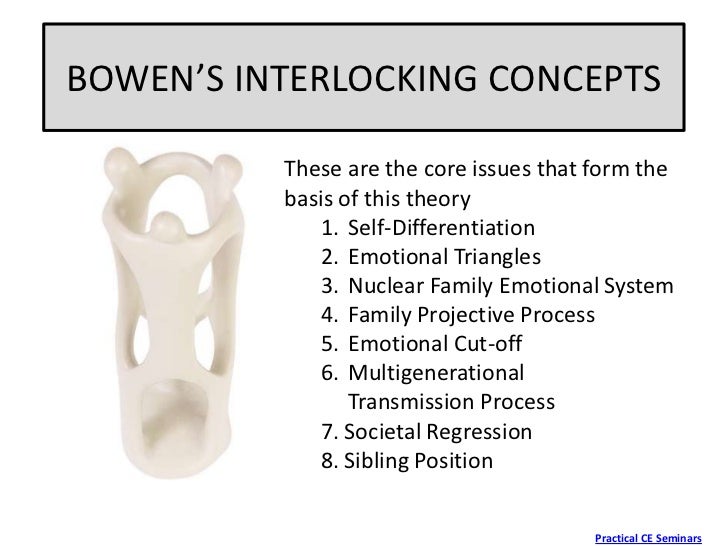
Bowen discovered and practiced several concepts. The following concepts are described by Michael Kerr (2000). Triangle is described as a relationship between three people, like an element or even a particle that is the most stable relationship. An example of this is a two of the three people may be parents and if there is ever stress between them, they will invite a third person to help alleviate the stress. The partner experiencing the stress will focus their energy on the third person and ignore the source of stress, the other partner. The third side of the triangle can be a child, work, and activities. (Kerr, 2000).
Next concept is Differentiation of self and this can be described as a person having the ability to have relationships with others without getting lost in another person’s self. People that are not able to differentiate their ‘self’ want to be liked so they will often conform under pressure. (Kerr, 2000). Bowen (1978) felt people needed their own feeling, thoughts, and emotions. (Bowen 1978)
Following that is Nuclear Family Emotional Process which explains that there are four patterns in a relationship that oversees where issues mature overtime in a family system. The first pattern is marital conflict which shows how when a married couple’s tension builds overtime, they will get anxious and attempt to control each other but that will not work as both will refuse to be controlled. The second pattern is dysfunction is one spouse, this explains how one partner may try to coerce the other spouse to behave a certain way but the partner will resist the pressure. It goes to further explain how one partner will do more to make the other happy but if tension arise, the spouse that does more may become especially anxious and this may lead to them having social, psychiatric, and medical issues. The third pattern is impairment of one or more children, this explains how a partner will focus their anxiety on one child or children. The parent will view the child in a negative light, that child will have behavioral issues due to the parents focusing negatively on him or her. This can affect the child’s productivity in school, social life, and even their mental health. The fourth pattern is called emotional distance, this pattern can be explained as a person bringing a relationship with another to halt to prevent that relationship from being too intense. (Kerr, 2000).
Family Projection Process goes on to describe how the parents’ problem gets conveyed on to a child. Children are able to obtain strengths and weaknesses from their parents, if the child’s parent is immature, the child will most likely emulate this. this will greatly affect the child’s development and behavior (Kerr, 2000).
Multigenerational Transmission Process is process can be best explained as a family with several children and the last child not feeling close to her parents. That child will attempt to seek approval from her parents and in turn feel left out of the family unit. That child will often look to their parents to decide and get anxious they may make the wrong decision (Kerr, 2000).
The last concept is Emotional Cutoff which is when a people have conflict with each other, but one person turning away, not dealing with the issues, and burying those feelings (Kerr, 2000).
Sibling position is the role taken by individuals in a relationship. According to Toman’s profiles, he reports that older children are more likely to be responsible and take a leadership role while younger children are more dependent and allow others to make decisions (Brown, 2014). Middle children are more flexible and with shifting between the two and only children are seen as more responsible (Brown, 2014). Bowen reports that a parent may identify more with the child closest to their sibling position when it comes to triangling (Brown, 2014).
Societal Emotional Process; Each concept in Bowen theory applies to nonfamily groups, such as work and social organizations. The concept of societal emotional process describes how the emotional system governs behavior on a societal level, promoting both progressive and regressive periods in a society. (Kerr, 2000)